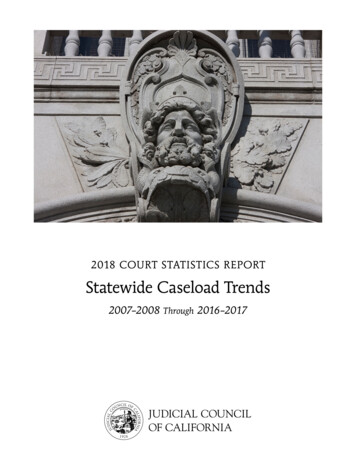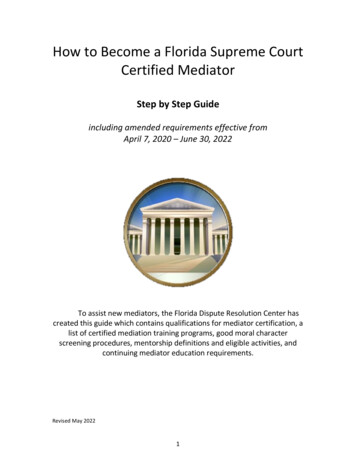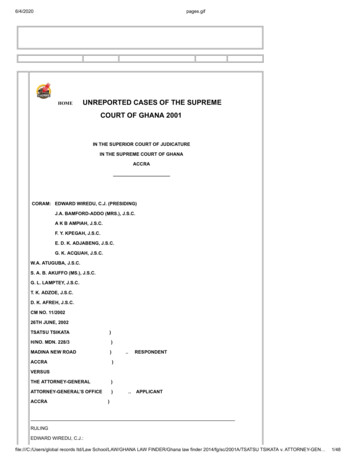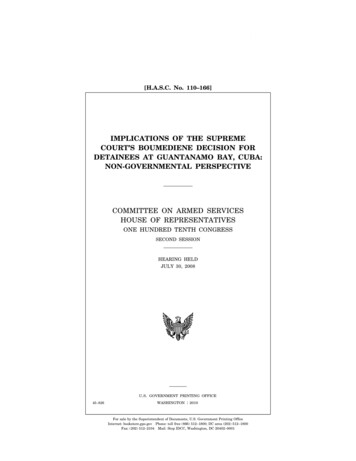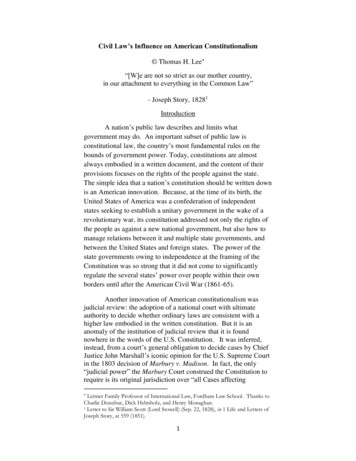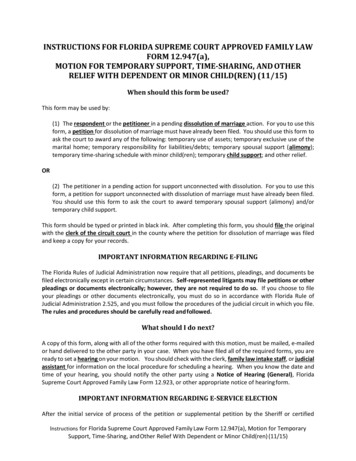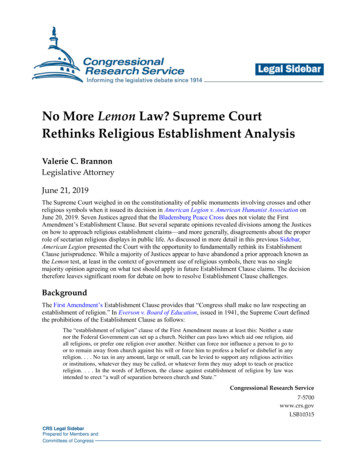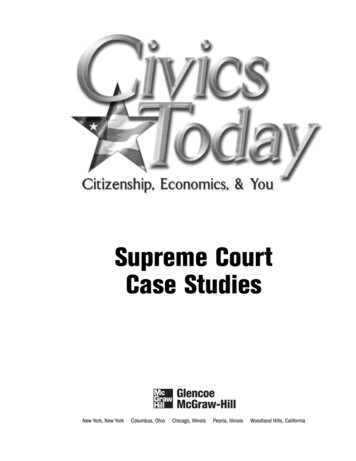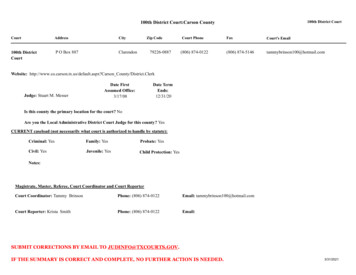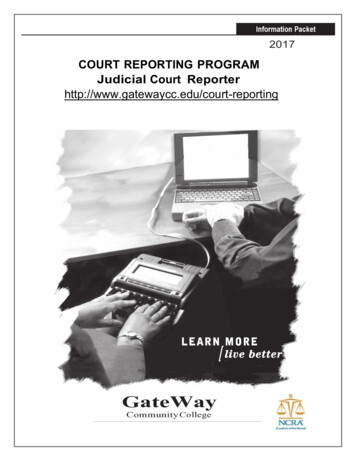
Transcription
Auto Safety Group Congress Watch Energy Program Global Trade Watch Health Research Group Litigation GroupBACKGROUNDERAugust 24, 2009U.S. Supreme Court May Unleash Flood ofCorporate Money Into ElectionsOn Sept. 9, Court to Revisit Landmark RulingsRestricting Corporate Money in PoliticsThe U.S. Supreme Court may soon unleash a flood of corporate money into our politicalsystem by announcing, contrary to long-standing precedents, that corporations have a constitutionalright to spend unlimited amounts of money to promote or defeat candidates.Already, corporations have ample means to influence our politics through campaigncontributions by wealthy corporate executives and lobbyists, as well as through corporate politicalaction committees (PACs), which are funded by contributions from corporate officers, shareholdersand employees.If they had a green light to spend unlimited amounts on races, not only would the nature ofelections change fundamentally—the threat of fighting a deep-pocketed industry candidate could pushlesser-funded candidates out of races altogether, for instance—but corporations would further crowdout the public in policymaking on health care, climate change and other critical issues.How did we arrive at this point?The Supreme Court sought it. In a stunning move, the Supreme Court has transformed a casethat posed a limited challenge to the McCain-Feingold law (Citizens United v. Federal ElectionCommission) into a sweeping challenge to a century-old pillar of campaign finance doctrine:restrictions on direct corporate and union financing of candidate campaigns.The court originally heard the case in March. But on June 29, it called for a second hearing andordered the parties to argue additional questions posed by the court itself: whether the court shouldoverturn well-established judicial precedents upholding restrictions on unlimited corporate and unionspending expressly advocating the election or defeat of candidates. Oral arguments will be heardbefore a packed courtroom at 10 a.m. Sept. 9 with a decision likely to be issued by year’s end. PublicCitizen’s Scott Nelson is one of the attorneys representing the key congressional sponsors of theMcCain-Feingold law and co-authored their amicus brief.1600 20th Street NW Washington, DC 20009-1001 (202) 588-1000 www.citizen.org215 Pennsylvania Ave SE Washington, DC 20003-1155 (202) 588-1000 www.citizen.org
2The decision will be nothing less than a historic moment in campaign finance law.At stake in the case is whether the court should overrule two existing Supreme Court decisions:Austin v. Michigan Chamber of Commerce—which held that the government can limit for-profitcorporations to the use of PACs to fund express electoral advocacy—and McConnell v. FEC, whichapplied that principle to uphold the constitutionality of the McCain-Feingold law’s restrictions on“electioneering communications,” that is, corporate funding of election-eve broadcasts that mentioncandidates and convey unmistakable electoral messages. Striking down these decisions would unleashunlimited corporate and union spending in candidate campaigns, and possibly doom the 1907 TillmanAct, which also prohibits corporate contributions to candidates.It is impossible to predict how much corporate and union money would flood into elections inan unregulated system, but it is reasonable to assume it would be very substantial indeed—andpossibly overwhelming in selected races of particular interest to the business or labor communities.Even before a single dollar was spent, the threat of corporate spending in elections could wieldsignificant influence over policymakers. Imagine the enormous political pressures these entities couldplace on Congress as it attempts to grapple with the major economic issues of the day with the loomingprospect of being punished or rewarded through direct campaign spending.Already, corporate interests have clout. Consider that the insurance and drug industries havebeen at the table since the beginning of the health care reform debate, successfully whittling away atcongressional proposals and ensuring that reforms do not eat into their profits. Witness, too, thestrength of the fossil fuel industry in climate change legislation; the current legislation is now a shell ofPresident Obama’s original proposal, giving polluters emissions credits for free and shrinking thepercentage of power that utilities must obtain from renewable energy.Now imagine if corporations had even more sway. The public would be further shut out of itsown government.Conversely, an unregulated campaign finance environment would expose corporations tocorrupt shakedowns for political money. Corporations would face intense pressure to provide directand indirect financial support for candidates to attract the attention of, and avoid retribution from,elected officials and their parties.Other probable ramifications of striking down the long-standing laws against direct corporateand union financing of elections include: Invalidating the laws of 24 states that currently prohibit or limit corporate spending in state andlocal elections. [For a listing of states that restrict corporate spending, go to:http://www.citizen.org/documents/Corporate spending on state candidates.pdf ]Unleashing direct corporate financing of judicial campaigns in the 39 states that allow forelection of judges. [For a listing of state judicial selection processes, go to:http://www.citizen.org/documents/Judicial selection chart.pdf ]1600 20th Street NW Washington, DC 20009-1001 (202) 588-1000 www.citizen.org215 Pennsylvania Ave SE Washington, DC 20003-1155 (202) 588-1000 www.citizen.org
3Any action by the Supreme Court in reversing well-established laws and judicialprecedents barring direct corporate and union financing of campaigns would be a radical affrontto the American political culture that recognizes the need to rein in corporate money in politics,and would pose grave dangers to the integrity of elections and government itself, and representjudicial activism at its worst.Citizens United v. Federal Election Commission—the Case That Sparked This ThreatAt the center of the legal battle is a Citizens United film about 2008 Democratic presidentialcandidate Hillary Clinton, titled “Hillary: The Movie.” The film has been shown in theaters andcirculated as a DVD. Those showings were not subject to the Bipartisan Campaign Reform Act of2002 (BCRA, also known as the McCain-Feingold law) because they were not broadcast. However,Citizens United also planned to show the movie through on-demand satellite transmissions, which fellunder BCRA’s definition of “electioneering communications” and would be subject to restrictions onwho may pay for them as well as to disclosure requirements. Citizens United also prepared three TVads to promote the movie. The ads fell under the campaign finance law’s definition of “electioneeringcommunications” and were therefore subject to disclosure requirements under BCRA.Electioneering communications are a relatively new class of campaign advertisementsregulated under BCRA. They include broadcast ads that depict a federal candidate within 60 days of ageneral election or 30 days of a primary election. Such ads are subject to disclosure of their funding,regardless of whether they are deemed “issue ads” or campaign ads, and subject to the ban oncorporate and union funding if they are the latter.On Dec. 13, 2007, Citizens United, a nonprofit membership corporation that accepts moneyfrom business corporations, filed a complaint in the U.S. District Court for the District of Columbiachallenging the constitutionality of the statutory provisions governing disclosure and funding of“electioneering communications.” On Jan. 15, 2008, the District Court denied Citizens United’smotion for a preliminary injunction, in which Citizens United requested that the court prevent theFederal Election Commission (FEC) from enforcing the law. The court later dismissed CitizensUnited’s lawsuit, and Citizens United petitioned the Supreme Court to hear the case.Though BCRA was held constitutional in nearly all respects by the Supreme Court in its 2003decision, McConnell v. FEC, a reconstituted court in 2007 limited the scope of that decision. In FEC v.Wisconsin Right to Life, the court ruled that the funding source limitations in the law apply only tocommunications that either directly urge a vote for or against an identified candidate, or are the“functional equivalent” of such express advocacy. Nevertheless, the disclosure requirement for allelectioneering communications remains intact.Three members of the Supreme Court in the majority of the 5-4 ruling in Wisconsin Right toLife—Justices Antonin Scalia, joined by Justices Anthony M. Kennedy and Clarence Thomas—suggested that they might be willing to cast aside the McConnell decision, as well as the 1990 decisionin Austin v. Michigan State Chamber of Commerce that allowed government regulation of corporatecampaign spending.1600 20th Street NW Washington, DC 20009-1001 (202) 588-1000 www.citizen.org215 Pennsylvania Ave SE Washington, DC 20003-1155 (202) 588-1000 www.citizen.org
4The Supreme Court heard arguments in the Citizens United case this spring and, on the last dayof its term, decided that it would require additional briefs in the case and hear additional arguments onSept. 9. According to the court order, the rehearing will go far beyond the original challenge posed byCitizens United and reconsider instead whether the entire framework restricting corporate and unionspending on explicit campaign advertising is constitutional.The very brief order reads as follows:“This case is restored to the calendar for reargument. The parties are directed to filesupplemental briefs addressing the following question: For the proper disposition ofthis case, should the Court overrule either or both Austin v. Michigan Chamber ofCommerce, 494.U.S. 652 (1990), and the part of McConnell v. Federal ElectionComm’n, 540 U.S. 93 (2003), which addresses the facial validity of Section 203 of theBipartisan Campaign Reform Act of 2002. 2 U.S.C. §441b.”How Restrictions on Corporate and Union Money in Politics EvolvedAt the turn of the last century, the patronage system for financing campaigns throughassessments on government salaries was quickly being displaced by corporate contributions, as moreand more business interests began aggregating large sums of wealth. Substantial corporate financing ofelections first became readily apparent in the 1896 presidential election.1 Corporate funding ofcampaigns became an all-out scandal in the 1904 presidential election, when the losing candidate,Alton Parker, publicly accused Theodore Roosevelt of secretly financing his campaign withcontributions from life insurance companies, a charge that was later supported in an investigation bythe state of New York.2 Public outrage ensued as it became evident that the insurance companies weresimultaneously seeking legislation from the federal government that would limit the ability ofpolicyholders to sue the companies.President Roosevelt sought to assuage the furor in his 1905 State of the Union address when heurged Congress to prohibit all corporate contributions to campaigns. Roosevelt proclaimed:“The fortunes amassed through corporate organization are now so large,and vest such power in those that wield them, as to make it a matter ofnecessity to give to the sovereign – that is, to the Government, whichrepresents the people as a whole – some effective power of supervisionover their corporate use.”31Matthew Josephson, THE POLITICOS, 1865-1896 (1938) at 699.2Adam Winkler, “Other People’s Money: Corporations, Agency Costs and Campaign Finance Law,” GeorgetownUniversity Law Journal, 92:871 (2004) at 886.3Theodore Roosevelt, State of the Union Address (Dec. 5, 1905), available at: www.theodoreroosevelt.com/sotu5.html.1600 20th Street NW Washington, DC 20009-1001 (202) 588-1000 www.citizen.org215 Pennsylvania Ave SE Washington, DC 20003-1155 (202) 588-1000 www.citizen.org
5Congress responded in 1907 by passing the Tillman Act. Introduced by Sen. Ben “Pitchfork”Tillman (D-S.C.),4 the act banned corporations from “mak[ing] a money contribution in connectionwith any election to any political office”—specifically, “any election at which Presidential and VicePresidential electors or a Representative in Congress is to be voted for or any election by any Statelegislature of a United States Senator.”5 The legislation specified that any corporation breaking theselaws could be subject to a fine of up to 5,000 (more than 114,000 in 2008 dollars), in addition topenalties of up to 1,000 and jail time for individuals in a corporation responsible for violating the law.The Tillman Act was eventually subsumed under the Federal Corrupt Practices Act of 1925.In 1943, in the War Labor Disputes Act, Congress temporarily extended the ban on corporatecontributions to labor unions. Large labor unions had evolved through the New Deal as another vehiclecapable of amassing large sums of money that could be used for political purposes. In the 1944elections, labor unions responded to the War Labor Disputes Act by diverting that money toindependent expenditures (rather than contributions) on behalf of their favored candidates. To closethis loophole, Congress enacted the Taft-Hartley Act of 1947 to clarify that both campaigncontributions and expenditures by corporations and unions were prohibited by law. The legislativehistory indicates that Congress believed both contributions and expenditures were already prohibitedby the Federal Corrupt Practices Act. As Sen. Robert Taft (R-Ohio) explained:“[T]he previous law prohibited any contribution, direct or indirect, inconnection with any election,” and the new legislation “only makes it clearthat an expenditure is the same as an indirect contribution, which, inmy opinion, has always been unlawful.”6The Federal Election Campaign Act of 1971 (FECA), as subsequently amended, incorporatedthe Taft-Hartley Act’s long-standing provision against corporate and union campaign contributions andexpenditures.Soft Money, Electioneering Communications and BCRADue to an exemption in the 1979 Amendments to the Federal Election Campaign Act, state andlocal parties were allowed to spend money otherwise prohibited in campaigns, such as corporate andunion treasury funds and contributions in excess of the limits, on grassroots organizing and votermobilization activities that affected state or federal elections. These additional party-building fundscame to be known as “soft money.” Subsequent regulations by the FEC expanded the soft moneyexemption, allowing the national parties also to raise and spend soft money for party-building andvoter-mobilization activities. In 1988, the FEC even permitted the national parties to use soft money topay for partisan television advertisements that benefited both state and federal candidates, as long asthe soft money was used to pay for the non-federal share of the costs.4Sen. Tillman kicked off the 1896 presidential campaign with a rousing speech on the Senate floor in which hechallenged President Grover Cleveland for doing very little to address the economic depression. Tillman made severalreferences to pitchforks and threatened to go to the White House and “poke old Grover with a pitchfork” to prod him intoaction. Afterward, the senator was known as “Pitchfork” Ben.5Tillman Act, 1907.6Sen. Taft, Congressional statement, 93 CONGRESSIONAL RECORD 6594 (1947).1600 20th Street NW Washington, DC 20009-1001 (202) 588-1000 www.citizen.org215 Pennsylvania Ave SE Washington, DC 20003-1155 (202) 588-1000 www.citizen.org
6The parties initially had been slow to take advantage of this new source of revenue—until the1996 reelection campaign of President Bill Clinton. In that election, the Democratic Party realized thesoft money exemption allowed the national party to raise unlimited amounts of soft money and thentransfer the funds to state parties. State Democratic parties, in turn, could spend soft money on nonfederal election activity, including television and radio advertisements, directly benefiting the Clintoncampaign.Both parties promptly turned their attention to soft money. In the 2000 election cycle, nationaland congressional party committees broke all previous records in soft money fundraising. NationalRepublican Party committees raised 249.9 million and spent 252.8 million in soft money, whilenational Democratic Party committees raised 245.2 million in soft money and spent 244.8 million.More than half of this soft money was transferred to state parties and used to pay for televisionadvertisements. Overall, 77 percent of party-sponsored television commercials relating to federalelections in the 2000 election were paid for by state parties. The national party committees and federalcongressional committees combined purchased about 23 percent of the party ads that addressed federalelections. Not surprisingly, most of this state party spending activity took place in the most competitivestates in the presidential election: Florida, Pennsylvania, California, Michigan, Washington andOhio. In other words, the national parties found a way to tap into corporate and union money and usethat money for television advertising on behalf of federal candidates, particularly for the presidentialcandidates.7Meanwhile, corporations and unions also found independent ways to spend their moneydirectly in elections, pouring millions of dollars into sham “issue ads” that evaded existing restrictionsby avoiding express statements advocating votes for or against candidates, but were unmistakablyaimed at particular candidates.Congress responded in 2002 by passing the Bipartisan Campaign Reform Act (BCRA). Twokey pillars of the act dramatically curbed the use of soft money. First, the act prohibits raising andspending soft money by federal officeholders and candidates and by the national parties, and restrictsthe use of soft money by state and local parties in relation to federal election activities. Second, BCRAredefines what constitutes a campaign advertisement that is subject to the disclosure requirements,contribution limits and prohibitions on the use of corporate and union money. Broadcastadvertisements that depict a candidate, target that candidate’s election district, and air within 30 daysof the candidate’s primary election or 60 days of the general election are defined as “electioneeringcommunications” subject to regulation under federal campaign finance laws. The electioneeringcommunications provision was the focus of the Citizens United challenge.Supreme Court Historically Has Backed Restrictions on Corporate Funding of ElectionsThroughout a century of restrictions on corporate and union campaign contributions andexpenditures, the Supreme Court has recognized that the large sums of money corporations and unionscan tap into to influence elections is problematic. For that reason, the court has generally granted7Craig Holman, The End of Limits on Money in Politics: Soft Money Now Comprises the Largest Share of PartySpending on Television Ads in Federal Elections, NYU’s Brennan Center for Justice (2001), available at:http://brennan.3cdn.net/f1b070cbd490336610 08m6bpvsf.pdf.1600 20th Street NW Washington, DC 20009-1001 (202) 588-1000 www.citizen.org215 Pennsylvania Ave SE Washington, DC 20003-1155 (202) 588-1000 www.citizen.org
7deference to Congress to restrict campaign contributions and expenditures. In reviewing the TaftHartley Act a half century after the Tillman Act, the court in U.S. v. United Automobile Workersrecognized that the aggregated wealth of corporations and unions, when used to affect candidateelections, could have “untoward consequences for the democratic process”8 and defended Congress’efforts to protect the electoral process “from what it deemed to be the corroding effect of moneyemployed in elections by aggregated power.”9The court first squarely addressed the restrictions on corporate financing of candidate electionsin FEC v. National Right to Work Committee following enactment of FECA. This case challenged thelaw’s requirement that corporations may finance candidate campaigns only through PACs that solicitcontributions from individuals within the company, subject to contribution limits and disclosure. Thecourt described the careful “step by step” evolution of federal law regulating corporate and unioncampaign spending and affirmed the PAC requirement. Congress, the court said, has a compellinginterest to “ensure that substantial aggregations of wealth” amassed by corporations are not “convertedto ‘political war chests’ which could be used to incur political debts from legislators.”10In FEC v. Massachusetts Citizens for Life, the court carved out an exception to the ban oncorporate political spending for ideological nonprofit corporations that were not established by a forprofit corporation, have no shareholders and do not accept contributions from business corporations.At the same time, it reaffirmed “the legitimacy of Congress’ concern” about the financing ofcampaigns by “organizations that amass great wealth in the economic marketplace.”11The court again affirmed restrictions on corporate spending in candidate elections in Austin v.Michigan State Chamber of Commerce. Citing its earlier decisions, the court found that thegovernment has a valid interest in ensuring that corporations do not spend their “resources amassed inthe economic marketplace to obtain an unfair advantage in the political marketplace.”12 In FEC v.Beaumont, the court relied on Austin once again to uphold the ban on corporate campaigncontributions, even as applied to nonprofit corporations. The court recounted a “century ofcongressional efforts to curb corporations’ potentially deleterious influences on federal elections.”13When the court reviewed BCRA for the first time in McConnell v. FEC, it acknowledged that“Congress’ power to prohibit corporations and unions from using funds in their treasuries to financeadvertisements expressly advocating the election or defeat of candidates in federal elections has beenfirmly embedded in our law.”14 Just a few years later, a reconstituted court in FEC v. Wisconsin Rightto Life partly cut back on the McConnell decision by narrowing the scope of the “electioneeringcommunications” provision of BCRA to allow corporate or union funding of such broadcast ads if they8U.S. v. United Automobile Workers, 352 U.S. 567 (1957) at 578.9U.S. v. United Automobile Workers, 352 U.S. 567 (1957) at 582.10FEC v. National Right to Work Committee, 459 U.S. 197 (1982) at 207-209.11FEC v. Massachusetts Citizens for Life, 479 U.S. 238 (1986) at 257.12Austin v. Michigan State Chamber of Commerce, 494 U.S. 652 (1990) at 659.13FEC v. Beaumont, 539 U.S. 146 (2003) at 152.14McConnell v. FEC, 540 U.S. 93 (2003) at 203.1600 20th Street NW Washington, DC 20009-1001 (202) 588-1000 www.citizen.org215 Pennsylvania Ave SE Washington, DC 20003-1155 (202) 588-1000 www.citizen.org
8are deemed “issue ads,” but continued to uphold the restriction for ads that are the functionalequivalent of express advocacy, such as by denigrating a candidate’s character.15Corporations Have Found Ways to Remain Involved in ElectionsBCRA was quite effective at closing the soft money loophole. The 500 million in soft moneygiven by corporations and unions to federal and state parties each election cycle vanished. But theparties adapted well to the new campaign finance system. Both the Democratic and Republicannational parties directed their fundraising efforts away from the large donations from corporations andunions and toward small donations from individuals.Republican national, state, and local party committees that report to the FEC raised 602.3million during 2005-2006 in federally permissible “hard money.” Democratic Party committees raised 483.1 million during the same period. Democratic Party receipts more than doubled compared with2002, the most recent cycle in which there was no presidential campaign, while Republican Partyfundraising grew by 42 percent. Overall, the parties’ national committee fundraising totals nearlyequaled their 2002 campaign cycle totals, the last year that the national party committees could raisesoft money.16 Both national parties also vastly increased the numbers of donors, building theirmemberships by millions of individuals.Though independent spending by outside groups increased, spending by outside groups in the2006 and 2008 elections was less than half the 500 million previously raised by the parties in softmoney. More important, corporate donations to these outside groups totaled less than 13 percent theamount corporations had donated in party soft money.17The electioneering communications section of the law was limited to candidate-specificbroadcast, cable and satellite communications to targeted audiences in close proximity to primary andgeneral elections. Its purpose was to extend the existing prohibition on corporate and unionexpenditures on express advocacy to what had become its functional equivalent. McCain-Feingold leftuntouched the many avenues for campaigning available to corporations and unions not covered by thebright-line test for electioneering (or by the ban on party soft money).Avenues for corporate and union involvement in campaigns that remain open include, forexample, issue advocacy, lobbying activity, partisan political communications among shareholders andmembers, contributions and independent expenditures through political action committees, sponsorshipof candidate and party appearances at forums and conventions, and the provision of nonpartisanregistration and mobilization of voters among the general public. PAC activity is particularly15FEC v. Wisconsin Right to Life, 127 S.Ct. 2652 (2007).16Federal Election Commission, “Party Financial Activity Summarized for the 2006 Election Cycle,” press release(March 7, 2007), available at: 20070307party.shtml.17Stephen Weissman and Ruth Hassan, “BCRA and the 527 Groups,” in Michael Malbin, ed. THE ELECTION AFTERREFORM (2006) at 90.1600 20th Street NW Washington, DC 20009-1001 (202) 588-1000 www.citizen.org215 Pennsylvania Ave SE Washington, DC 20003-1155 (202) 588-1000 www.citizen.org
9prevalent, with 1,598 corporate PACs, 272 labor PACs and 995 trade association PACs registered in2009.18Conclusion: The Potential Damage of Unrestricted Corporate Financing of CandidateCampaigns Is EnormousIf the Supreme Court rules that the restriction on corporate and union financing of elections,and perhaps even the disclosure of funding sources behind certain types of campaign advertising, areunconstitutional, the decision would radically alter the way elections are financed. The FEC’s July 24brief defending the laws argued that the Supreme Court’s contemplated repudiation of long-standingcampaign finance precedents “would fundamentally alter the legal rules governing participation ofcorporations—including the nation’s largest for-profit corporations—in electoral campaigns and wouldmake vast sums of corporate money available for overt electioneering.”Moreover, the FEC noted that the corporations are “artificial persons” with great moneymaking advantages over natural persons, with whom they might compete for influence over theelectoral process. Corporations accumulate other people’s money, and because they “do not age, retire,or die, they can amass great wealth from their business activities even while changing owners,directors and officers as needed.”Since this nation has not seen a political landscape with unlimited corporate spending in recentmemory, it is difficult to know for sure how much more money will pour into elections. But recentpatterns of corporate spending on “sham issue ads” that are designed to affect candidate electionsstrongly suggest that new direct corporate spending could flow in staggering amounts. Immediatelyprior to passage of BCRA, the national parties coordinated some 500 million in soft money in each ofthe 2000 and 2002 election cycles, primarily from corporate and union sources, and spent the bulk ofthis money on television advertising. Non-party outside groups, which also tapped corporate and unionmoney, spent another conservatively estimated 100 million in the 2000 election cycle alone onelectioneering TV ads, up from 11 million spent by outside groups on electioneering ads just twoyears earlier.19In state judicial elections, which largely fall outside the constraints of BCRA, corporatespending for and against judicial candidates is already growing. In 2006, outside groups spent morethan 5 million on television ads promoting or attacking state supreme court candidates immediatelybefore their elections, up from 2.8 million in 2000.20 This corporate spending is usually indirect—organized and funneled through the Chamber of Commerce or other business associations. One canonly speculate as to the likely spike in corporate campaign spending if the Supreme Court lifts all stateconstraints on corporate political activity.18Federal Election Commission, Number of Federal PACs Increases (March 9, 2009) available tml.19See, for example, Craig Holman and Luke McLoughlin, BUYING TIME 2000: TELEVISION ADVERTISING IN THE2000 FEDERAL ELECTIONS (2001) at 29.20James Sample, Lauren Jones and Rachel Weiss, THE NEW POLITICS OF JUDICIAL ELECTIONS 2006 (May 2007).1600 20th Street NW Washington, DC 20009-1001 (202) 588-1000 www.citizen.org215 Pennsylvania Ave SE Washington, DC 20003-1155 (202) 588-1000 www.citizen.org
10Unlimited corporate and union spending in elections would likely arrest the current populartrend toward small
1600 20 th Street NW Washington, DC 20009-1001 (202) 588-1000 www.citizen.org 215 Pennsylvania Ave SE Washington, DC 20003-1155 (202) 588-1000 www.citizen.org 4 The Supreme Court heard arguments in the Citizens United case this spring and, on the last day of its term, decided that it would require additional briefs in the case and hear additional arguments on
